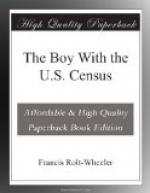“So that really the sorting into sexes is done by the one and the same operation as the punching of the card,” the boy remarked; “I see now. That’s a first-class idea.”
“It saves a great deal of work,” the older man said. “Then, too, with the same group of motions a new card has been fed from the holder and is in place for punching. At the same time, the schedule, which is held in rigid alignment, has been turned just exactly the right amount to bring the next line in the direct vision of the operator. Thus he never has to stop and think whether he has done a line or not and never skips a line because of an error of eyesight.”
“I can understand that now,” the boy answered “Now let me see whether I really can do the rest of the card. In what you call the third column—though it is really the fifth—I punch either ‘Hd’ for the Head of the Family, ‘Wf’ for Wife, ‘S’ or ‘D’ for Son or Daughter, and ‘Ot’ for Other?”
“That’s right.”
“Then, further down the same line, ‘M’ is Male and ‘F’ is Female. That’s easy enough. In the next section down, but still in the same line is ‘W’ for White, ‘Mu’ for Mulatto, ‘B’ for Black, ‘Ch’ for Chinese, ‘Jp’ for Japanese, and ‘In’ for Indian.”
“Go ahead,” the foreman said, “you’re not likely to go wrong as yet.”
“The age seems clear, too,” said Hamilton, “you punch the five-year period nearest to the age and then add on. For instance, the way it looks to me is that if a fellow was sixteen, you would first punch the ‘15’ and then the ‘1’ in that little cornerwise bit at the bottom of the next section. But I don’t see what the ‘5’ is for.”
[Illustration: FACSIMILE OF PUNCHED CENSUS CARD. Example of record made for every person in the United States, this card being the actual record of the author.]
“That’s for babies in the sixth division of the first year, or from nine to eleven months old; the first division means under one month, and the rest either one, two, or three months apiece.”
“I see it all now,” exclaimed the boy, “you have to punch two holes for age for every person. For a boy of ten, you would have to punch the ‘0’ as well as the ‘10,’ I suppose, to make sure he isn’t older and the extra years forgotten.”
“That’s the reason exactly.”
“The meaning of the section next to the age is easy, too,” Hamilton continued. “‘S’ for Single, ‘M’ for Married, ‘Wd’ for Widowed, ‘D’ for Divorced, ‘Un’ for unknown, any one could guess. But this ’Mother Tongue’ business has me going.”
“I thought it would,” was the reply. “But it’s not so hard if you remember a few things, particularly that the language of a country is not always spoken by the greatest number of its inhabitants. Now the mother tongue of Wales is Welsh, but a large proportion of the people do not speak Welsh. Thus an English-speaking Welshman’s card would be punched ‘OL,’ meaning Other Language, or the language next in importance to the mother language of the country.”




